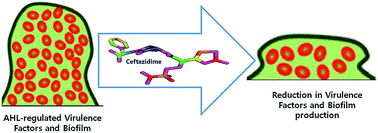Broad-spectrum inhibition of AHL-regulated virulence factors and biofilms by sub-inhibitory concentrations of ceftazidime
Abstract
Quorum sensing (QS) in bacteria is a density dependent communication system that regulates the expression of genes, including production of virulence factors in many pathogens. The emergence of antibiotic resistance among pathogenic bacteria represents a major threat in both hospitals as well as environmental settings. Interference of quorum sensing (QS)-regulated virulence factors and biofilms is a recognized anti-pathogenic therapy. Safe, stable and effective anti-QS agents are needed to combat diseases caused by multidrug-resistant bacteria. The present study was performed to assess the inhibitory effect of third generation antibiotic ceftazidime against Gram-negative bacterial pathogens. Sub-MICs of ceftazidime demonstrated dose dependent inhibition of QS regulated virulence traits and biofilm formation in various strains of Chromobacterium violaceum (CV12472 and CVO26), Pseudomonas aeruginosa (PAO1 and PAF79) and Aeromonas hydrophila (WAF38). β-galactosidase assay revealed ceftazidime inhibited the las and pqs QS systems in P. aeruginosa. Alongside, in vivo studies demonstrated enhanced survival of Caenorhabditis elegans after the treatment with the drug. Molecular docking analysis showed the high binding affinity of ceftazidime which represents its QS inhibitory activity. By highlighting the broad spectrum anti-quorum sensing and biofilm inhibiting activities against 3 different bacterial pathogens, ceftazidime seems a more potent candidate in counteracting the infections caused by drug resistant bacteria.


 Please wait while we load your content...
Please wait while we load your content...